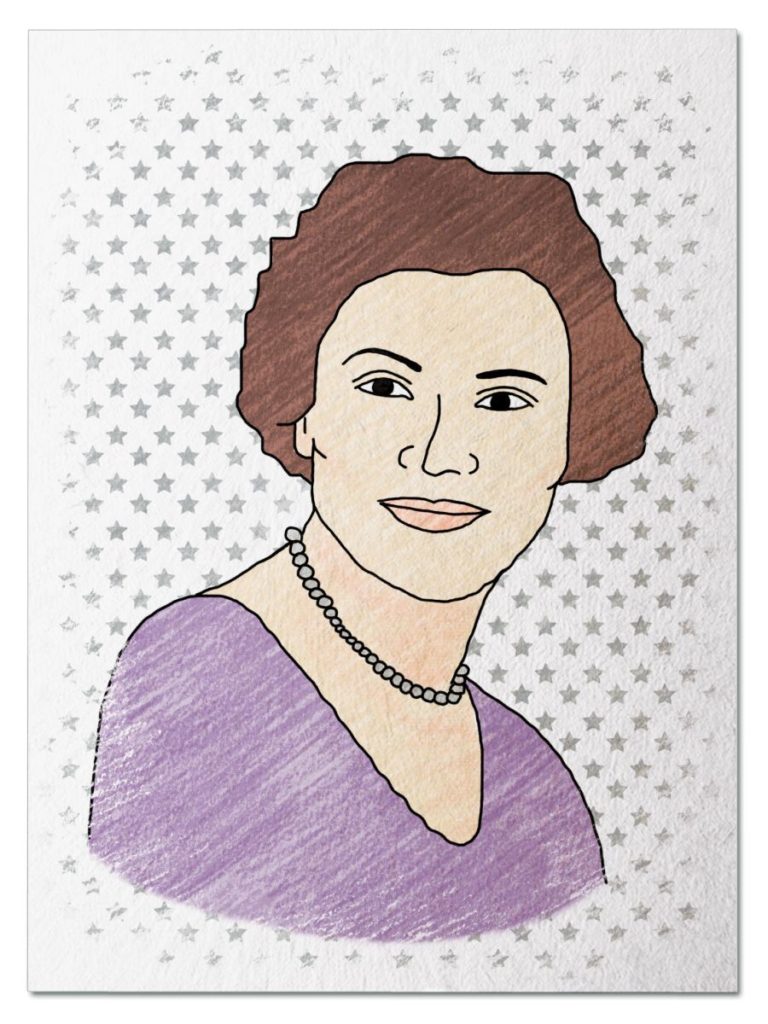
Culture Changer
Her career as a highly regarded scientist who worked in one of the most important military labs in the United States took a detour when her newborn son suffered an illness that left him developmentally disabled. Once she realized how few resources were available to families like hers, she devoted the rest of her life to developing and advocating for greater assistance and opportunities for children and adults like her son. Stand with Elizabeth Boggs in 1963 as she witnesses President Kennedy sign landmark legislation that opened a whole new world for the developmentally disabled…
Her Ruby Shoe Moment
The Power of the Wand
Her Yellow Brick Road
Brains, Heart & Courage
Glinda’s Gallery
Just the Facts
Her Ruby Shoe Moment
Elizabeth Boggs never expected to be a women who advised the President of the United States on social policy, but a twist of fate brought her to John F. Kennedy’s attention. Elizabeth was a mathematician and chemist who had planned a career in laboratory research. But her path diverged when her son David, who was now almost 18, was born with severe physical and mental disabilities.
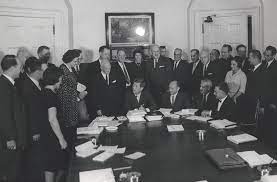
Elizabeth and the President’s Panel meeting with JFK in 1962 (Rutgers University)
There was little community or governmental support for children like David and their families. Elizabeth had no idea how much needed to change until she became the parent of a disabled child herself. Once she understood the plight of families like hers, she resolved to become a fierce advocate in any way she could, and had made her name and abilities known.
President Kennedy, whose oldest sister Rosemary was developmentally disabled, had commissioned a Panel on Mental Retardation. He had seen first hand how difficult life was for those with developmental disabilities. They were excluded from most of mainstream society, including schools. There were no accommodations to make participating in community activities possible. Employers weren’t interested in taking a chance on them. Their families had nowhere to turn for home care assistance, which meant that most developmentally disabled children and adults were institutionalized. The facilities available to them were typically huge and impersonal with inadequate funding and staffing. The residents were often abused or neglected.
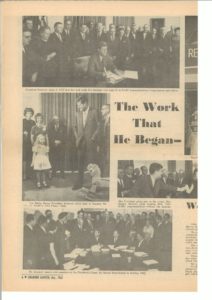
NARC Newsletter December 1963 (JFK Archives)
Elizabeth was invited to join the Panel, and eagerly agreed to devote her time to its efforts. She served as Vice Chair of the Panel’s Task Force on the Law. She and her fellow advocates studied, debated, and proposed various policies to improve the life of people with developmental disabilities. When the Panel presented its recommendations, titled “A Proposed Program for National Action to Combat Mental Retardation” to President Kennedy, he was so moved by its findings that he resolved to help lobby Congress to pass their programs into law. The President sent a personal message to Congress in February 1963 with the Panel’s recommendations.
Many in Congress were similarly moved and persuaded by Elizabeth and her colleague’s work. Many of their proposals became law, including the Maternal & Child Health and Mental Retardation Planning Amendments and the Mental Retardation Facilities and Community Mental Health Centers Construction Act. These laws provided critical funds for building accessible community facilities and for needed research on developmental disabilities.
But Elizabeth wasn’t satisfied. She kept working, lobbying, and pushing. Congress kept responding. President Lyndon B. Johnson asked her to be on his President’s Committee on Mental Retardation, and in 1967, she lobbied successfully to expand intellectual disability services.
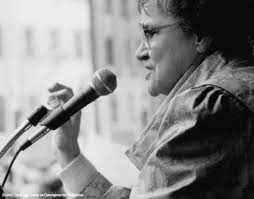
Elizabeth became a persuasive speaker and advocate for the developmentally disabled (Rutgers University)
In 1970, she was part of a small group that drafted the Developmental Disabilities Act, which made major amendments to the 1963 Construction Act. This Act defined “developmental disability” in the law for the first time. Elizabeth lobbied for a broad definition, because she had met so many families with different challenges. The statute now applied to a broad range of neurological issues, including cerebral palsy and epilepsy.
This work wasn’t political for Elizabeth, and she was willing and able to work with politicians and policy makers from all parties. When President Richard Nixon commissioned his President’s Committee on Mental Retardation in 1974, Elizabeth again answered the call. The Committee explored ways to educate the public in order to build acceptance and to further develop and support services to help families with any extra burden of care. This included incentives for employers to give developmentally disabled citizens a chance to work in a supported environment.
The Power of the Wand
Elizabeth was passionate in her belief that people with developmental disabilities should be made a part of their communities, and not separated from them. She lobbied for developmentally disabled Americans to be given the opportunity to contribute to society through self-care and productive work wherever possible. She knew how important it was for them to be able to demonstrate their abilities instead of being seen only as disabled.
An amazing present day example of Elizabeth’s dream is Bitty and Beau’s Coffee, a company founded by Amy & Ben Wright. Amy & Ben have 4 children – 2 of whom were born with Down’s Syndrome and one of whom is autistic. They opened their first coffee shop in Wilmington, North Carolina to provide work for people with intellectual and developmental disabilities. Their goal is to “create a path for people with disabilities to become more valued, accepted, and included in every community.” From that first shop, Bitty and Beau’s have grown to 23 locations in 12 states, employing 200 people.
Her Yellow Brick Road
In 1945, Elizabeth and her husband Fitzhugh, a fellow scientist, eagerly awaited the birth of their baby. He was born healthy, but developed a high fever shortly after birth that continued for days. Doctors prescribed antibiotics, which were newly available for non-military use, and initially believed that he would completely recover.
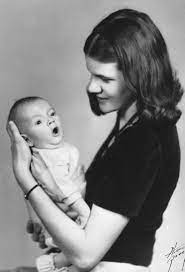
Elizabeth with her son David (Rutgers University)
But as David grew, their lives took an unexpected turn as it became obvious that he wasn’t developing like a typical child. Elizabeth visited doctor after doctor and was frustrated by the lack of knowledge the medical community had regarding how to treat and care for developmentally disabled children. She was advised to commit David’s care to an institution specifically designed to care for children like him.
Instead, Elizabeth decided to give up her math and chemistry pursuits in order to devote as much time as she could to making the world a better place for her son. She had quickly discovered that there were not many options or resources available for improving the lives of the developmentally disabled.
Elizabeth did what she did when faced with a seemingly unsolveable math or science challenge – she resolved to dig into the details and learn everything she could about the topic. She decided she needed to return to school in order to be prepared to help David and other children like him. She found classes in special education and social work administration – very different topics than her math and science, but the research and critical thinking skills she developed in her first career served her well. She also met other families in similar circumstances and spoke with them about what they needed.
Elizabeth then applied what she had learned to start a class for David and other children with developmental disabilities. She hosted the class in her home and eventually had 50 children participating. Nothing of its kind had been done before in her area. As David grew, his limited use of his arms and legs became more difficult for Elizabeth and Fitzhugh to handle without help. When he was 7 they made the painful choice to move him into the Hunterdon Developmental Center in Clinton, New Jersey. It was just 6 miles away from their home in a nearby town, so they visited him often.
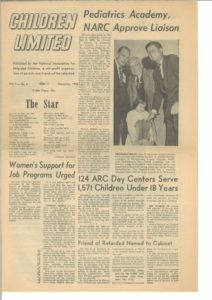
NARC Newsletter December 1960 (JFK Archives)
As she learned more, her programs flourished and her reach grew. Elizabeth wanted to expand these resources to children and families nationwide. She founded the National Association for Retarded Children in 1950 (now The Arc of the United States). The NARC was primarily a group of parents coming together to advocate for their children. Elizabeth became its first woman president in 1958. She started working with the organization’s Governmental Affairs Committee and realized she had a talent for policy and for persuasion. As she made a strong impression as a fierce advocate, national policymakers, including the President of the United States, took notice.
Brains, Heart & Courage
Elizabeth was born in Ohio, but spent most of her childhood in Rye, New York after her family moved there. Tragically, her brother Willis died when she was 7, leaving her parents heartbroken. Elizabeth and her other brother Frank learned at a young age that tragedy can strike and disrupt the best laid plans.
 Elizabeth’s favorite subjects in school were math and science, even though in the 1920s, they weren’t considered entirely suitable for girls and women to enjoy. Elizabeth ignored those who suggested she should pursue more feminine topics, and applied to Bryn Mawr College as a math major. She was accepted, and continued her pattern of strong study habits and determination to master any material put in front of her. After she graduated in 1935 with a degree in Math, summa cum laude with distinction, Elizabeth was accepted into a graduate program at Cambridge University in England.
Elizabeth’s favorite subjects in school were math and science, even though in the 1920s, they weren’t considered entirely suitable for girls and women to enjoy. Elizabeth ignored those who suggested she should pursue more feminine topics, and applied to Bryn Mawr College as a math major. She was accepted, and continued her pattern of strong study habits and determination to master any material put in front of her. After she graduated in 1935 with a degree in Math, summa cum laude with distinction, Elizabeth was accepted into a graduate program at Cambridge University in England.
Elizabeth spent many happy years at Cambridge, where her doctoral work involved researching and developing technology that would form the foundation for the first computer. She earned her Ph.D. in Theoretical Chemistry and Mathematics in 1939. World War II had started in Europe, and England decided to ban any foreign nationals from working in military related research labs. Elizabeth’s work was considered war related, so she had to return to the United States. 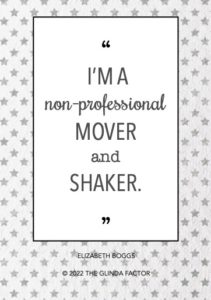
Her research had caught the attention of the U.S. defense industry, which was transferring to a war footing in response to German and Japanese aggression around the world. Elizabeth began working at a lab where she worked on developing explosives for military use. She shared her lab space with a fellow scientist named Fitzhugh Boggs and the two of them fell in love. They got married in 1941, kept working together through the war, and began planning to start a family.
Glinda’s Gallery
Just the Facts
- Elizabeth Monroe was born in 1913 in Cleveland, Ohio.
- Elizabeth married Fitzhugh Boggs in 1941. Their son, Jonathan David (called David) was born in 1945. David died in 2000.
- In 1978, Elizabeth testified before Congress to lobby legislators to not cut social security benefits of developmentally disabled people who wanted to work. She successfully argued they should not be discouraged from work by losing the benefits, like special equipment, transportation, personal assistance, health and social services, that were essential to their dignity.
- Elizabeth worked with the International League of Societies for the Mentally Handicapped and was a principal author of the United Nations Declaration of General and Special Rights of the Mentally Retarded.
- Elizabeth received honorary degrees from the University of Medicine and Dentistry of New Jersey, Kean College, and The Ohio State University.
- Elizabeth won several awards for her work on behalf of the developmentally disabled, including The Arc of New Jersey’s Humanitarian Award, the Kennedy International Award for Leadership, the Distinguished Public Service Award HEW, the Distinguished Service Award UCPA, the Wallace Wallin Award CEC, the N. Neal Pike Prize for Service to People with Disabilities. She was recognized by the American Association of University Affiliated Programs, the Arc-US, and the President’s Committee on Employment of People with Disabilities. She was a Life Fellow of AAMR, an Honorary Fellow of the American Psychiatric Association and the American Academy of Pediatrics.
- Elizabeth was hired by the New Jersey Office of Prevention of Mental Retardation and Developmental Disabilities to be its acting Director in 1988. In all her years of working on behalf of people with developmental disabilities, it was the only time she was paid for her labor.
- In 1990, Elizabeth was appointed by Congress to the Task Force on Rights and Empowerment of People with Disabilities. She co-chaired it with Justin Dart. This was critical work that led to Congress passing the Americans with Disabilities Act.
- Elizabeth died on January 27, 1996 after being seriously injured in a car accident. She was 82 and still working. At the time of her death, she was serving as part of the Social Security Administration’s Task Force on Representative Payees.
- After her death, New Jersey renamed its federally designated University Affiliated Program the Elizabeth M. Boggs Center on Developmental Disabilities.
Want to Know More?
Elizabeth Boggs Personal Papers (John F. Kennedy Archives)
Stewart, John F. “Elizabeth M. Boggs Oral History Interview” (John F. Kennedy Archives July 17, 1968)
Groce, Nora “Elizabeth Monroe Boggs” (World Institute on Disability via NPR).
Staff. “History of the DD Act” (Administration for Community Living).
Staff. “About Elizabeth M. Boggs, Ph.D.” (Rutgers Robert Wood Johnson Medical School).
